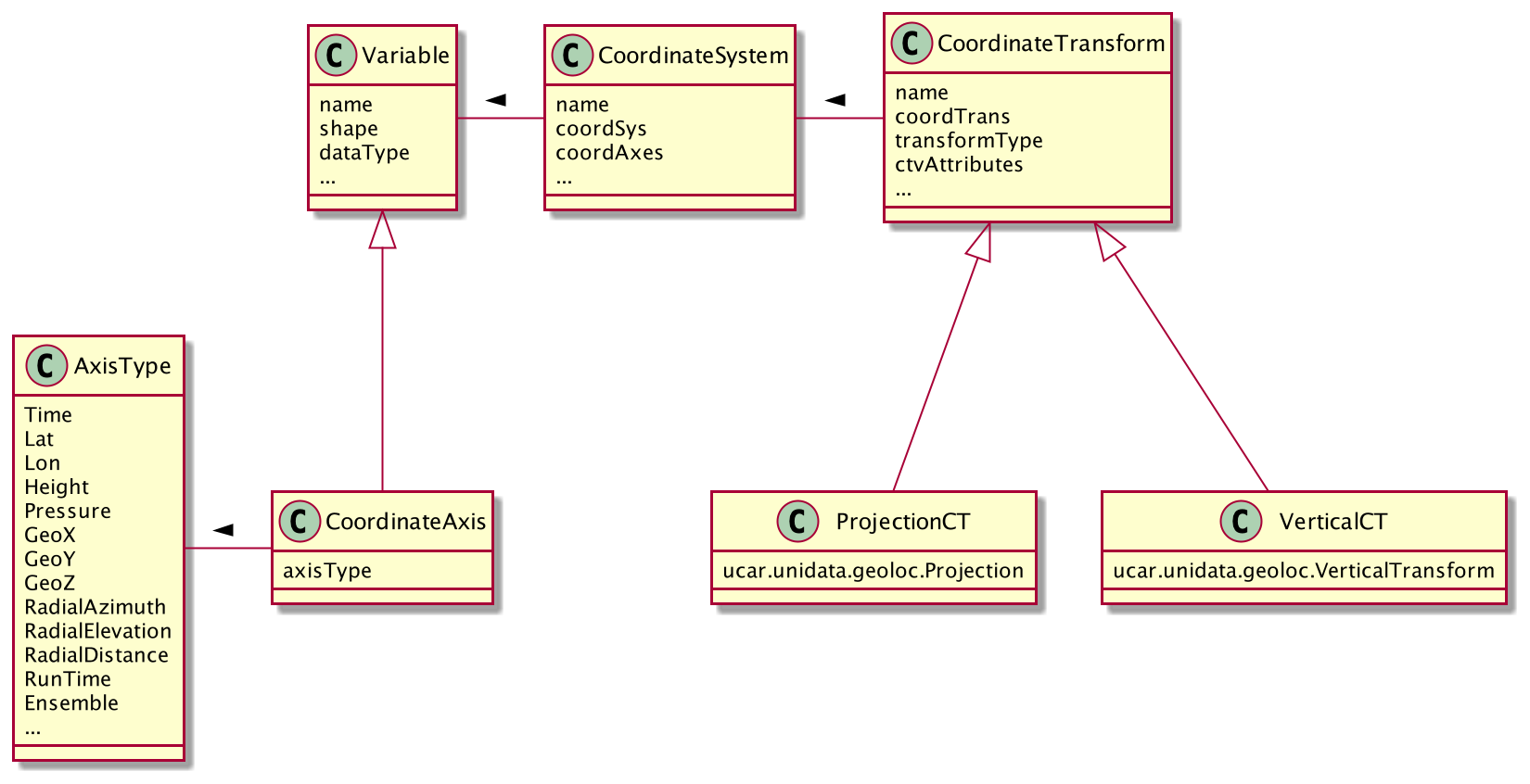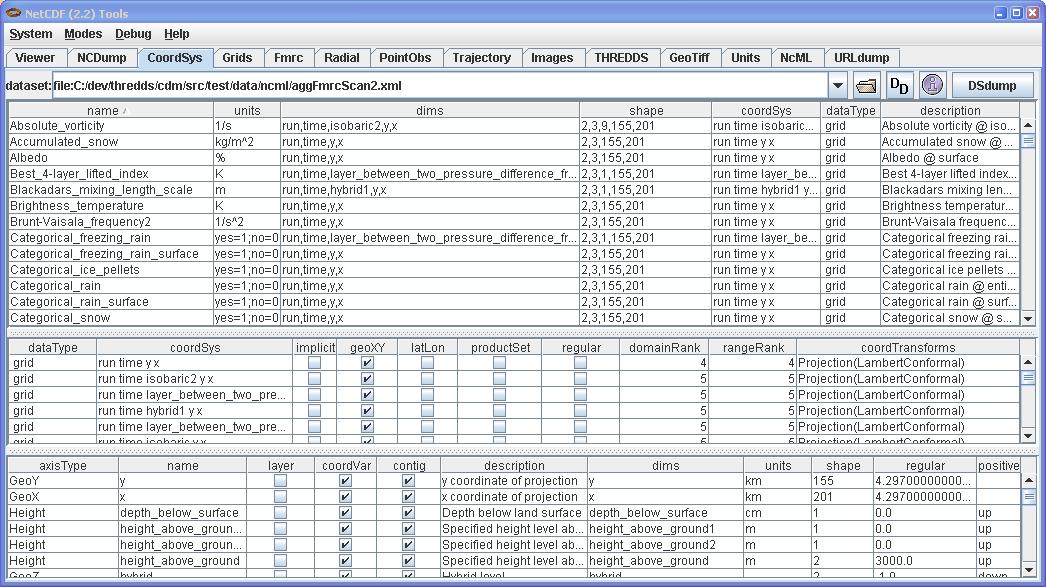Tutorial: Working with NetcdfDataset
The ucar.nc2.dataset classes are an extension to the NetCDF API that provide support for
- processing standard attributes for scale/offset and missing data
- general and georeferencing coordinate systems
- the NetCDF Markup Language (NcML)
- remote access to OpenDAP, ADDE and THREDDS datasets.
NcML is an XML document format that allows you to create “virtual” netCDF datasets, including combining multiple netCDF files into one dataset. The NcML tutorial explains how to create virtual datasets.
Using NetcdfDataset.openFile to open a NetcdfFile
The preferred way to open a NetcdfFile is through the NetcdfDatasets.openFile factory method:
try (NetcdfFile ncfile = NetcdfDatasets.openFile(pathToYourFileAsStr, null)) {
// Do cool stuff here
} catch (IOException ioe) {
// Handle less-cool exceptions here
logger.log(yourOpenNetCdfFileErrorMsgTxt, ioe);
}
NetcdfDatasets.openFile does the following:
- Opens an OPeNDAP remote dataset, if the location is a URL that starts with
http:,dods:,dap4:(version 4.4+) - Opens a CdmRemote dataset, if the location is a URL that starts with
cdmremote: - Opens a THREDDS dataset, if the location look like
thredds:<catalog>#<datasetId> - Opens an NcML dataset, if the location ends with
.xmlor.ncml, or is a URL starting withncmdl:(version 4.4+) - Otherwise, calls
NetcdfFile.open, which handles local file or HTTP access to any CDM file.
For more information, see the Dataset URL documentation.
Using NetcdfDataset.openDataset to open an enhanced NetcdfDataset
When you want the Netcdf-Java library to deal with missing values and scale/offset unpacking, and to identify coordinate systems,
you should use the NetcdfDatasets.openDataset factory call:
try (NetcdfDataset ncf = NetcdfDatasets.openDataset(pathToYourDatasetAsStr)) {
// Do cool stuff here
} catch (IOException ioe) {
// Handle less-cool exceptions here
logger.log(yourOpenNetCdfFileErrorMsgTxt, ioe);
}
Note that NetcdfDataset is a subclass of NetcdfFile, and so can be used wherever a NetcdfFile is used. NetcdfDatasets.openDataset does the following:
- Calls
NetcdfDatasets.openFileand wraps the returnedNetcdfFilein aNetcdfDataset, if necessary. - Processes missing values and scale/offset attributes, modifying
Variabledata types if necessary - Calls the appropriate
CoordinateSystemBuilderclass to identify the coordinate systems and populate theCoordinateobjects.
Packed data variables and missing values
When you open a NetcdfDataset in enhanced mode (the default), any Variables that have the attributes scale_factor and/or add_offset are considered to be packed data Variables, whose data should be converted with the formula:
double unpacked_data_value = packed_data_value * scale_factor + add_offset;
Usually the packed data type is byte or short and the unpacked type is float or double, so the data type of the packed data Variable is promoted to float or double.
Missing data is indicated by the valid_min, valid_max, valid_range, missing_value, or FillValue attributes. When a Variable has any of these attributes, the VariableDS.hasMissing method returns true.
You can test for missing values with the VariableDS.isMissing(value) method.
To open a NetcdfDataset in enhanced mode in Tools UI, toggle the enhance button
 on the ToolsUI Viewer tab to ON.
on the ToolsUI Viewer tab to ON.
Coordinate systems
NetcdfDataset will try to identify the coordinate systems in the dataset by calling a CoordSystemBuilder class that knows how to interpret the Conventions for that dataset.
The information is placed in Coordinate objects that follow this abstract model (see the javadoc for the specifics):

To write your CoordinateSystemBuilder, see here. To see the list of CoordinateBuilder classes, look at the source code in the ucar.nc2.dataset.conv package.
When writing netCDF files, we recommend using the Climate and Forcast (CF) Convention, if possible.
When an IOSP reads in a non-netCDF file, it should choose a Convention to encode the coordinate systems.
Using ToolsUI to view Coordinate Systems
You can use ToolsUI CoordSys tab to view the coordinate systems that have been constructed. The view consists of 3 tables that show the data variables, the coordinate systems, and the coordinate axes.

Advanced Use of NetcdfDataset (version 4.2+)
The following is applicable to version 4 of the Netcdf-Java library. Netcdf-Java version 2.2 effectively has only two enhance modes, All and None.
NetcdfDataset.Enhance
The enhancements made when a NetcdfDataset is opened are described by NetcdfDataset.Enhance, an enumerated type with the following possible values:
ScaleMissing: process scale/offset/missing attributes, and convert dataScaleMissingDefer: calculate scale/offset/missing info, but do not automatically convert dataCoordSystems: just add coordinate systemsConvertEnums: convert enums to Strings
When using the ScaleMissing enhance mode, scale/offset/missing attributes are processed when the dataset is opened,
and the data type of a Variable is promoted if necessary to match the unpacked data type. Data is automatically converted when read.
When using the ScaleMissingDefer enhance mode, scale/offset/missing attributes are processed when the dataset is opened,
but the data type of a Variable is NOT promoted, and data is not converted. After reading data, you can convert the entire Array with VariableEnhanced.convertArray(Array data),
or convert single values with conversion methods such as VariableEnhanced.convertScaleOffsetMissing(byte value).
When using CoordSystems enhance mode, CoordSysBuilder is called to populate the coordinate system objects in the NetcdfDataset when the dataset is opened.
When using ConvertEnums enhance mode, Variables of type enum are promoted to String types and data is automatically converted using the EnumTypedef objects,
which are maps of the stored integer values to String values.
The enhancement of a dataset can be controlled by passing in a Set of Enhance to NetcdfDataset.openDataset. The default enhance mode is:
Set<Enhance> EnhanceAll = Collections.unmodifiableSet
(EnumSet.of(Enhance.ScaleMissing, Enhance.CoordSystems, Enhance.ConvertEnums));
and can be changed through NetcdfDataset.setDefaultEnhanceMode(Set<Enhance> mode).
The simplest factory method, NetcdfDataset.openDataset(location), uses the default enhance mode.
Other factory methods with a boolean enhance parameter, such as NetcdfDataset.openDataset(String location, boolean enhance, CancelTask cancelTask),
use the default enhance mode if enhance is true, and EnhanceMode.None if enhance is false. Other classes, such as GridDataset, also use the default enhance mode.
Advanced options when opening
The most general factory method for opening a NetcdfDataset allows one to explicitly set the EnhanceMode:
// public static NetcdfDataset openDataset(DatasetUrl location, Set<Enhance> enhanceMode, int buffer_size,
// CancelTask cancelTask, Object spiObject)
NetcdfDataset ncd = NetcdfDatasets.openDataset(datasetUrl, enhanceMode, buffer_size, cancelTask,
serviceProviderInstance);
One can also set the buffer size used for reading data, pass in a CancelTask object to allow user cancelling,
and pass an arbitrary object to the IOServiceProvider that handles the dataset.
These last 3 parameters correspond to the parameters in the similar factory method for opening a NetcdfFile:
// public static NetcdfFile openFile(DatasetUrl location, int buffer_size, CancelTask cancelTask, Object spiObject)
NetcdfFile ncfile =
NetcdfDatasets.openFile(datasetUrl, buffer_size, cancelTask, serviceProviderInstance);
Caching NetcdfDataset and NetcdfFile
Advanced applications, like servers, might want to enable the caching of NetcdfDataset and NetcdfFile objects in memory, for performance.
Caching is safe to use in a multithreaded environment, such as a servlet container like Tomcat. Caching keeps resources, such as file handles, open,
so cache sizes should be carefully considered.
To enable caching, you must first call NetcdfDataset.initNetcdfFileCache(int minElementsInMemory, int maxElementsInMemory, int period);
where minElementsInMemory is the number of objects to keep in the cache when cleaning up, maxElementsInMemory sets a threshold to trigger
a cleanup if the cache exceeds it, and period specifies the time in seconds to do periodic cleanups.
One then calls the acquireFile or acquireDataset factory methods instead of openFile and openDataset. For example:
// on application startup
NetcdfDatasets.initNetcdfFileCache(100, 200, 15 * 60);
// instead of openFile
NetcdfFile ncfile = NetcdfDatasets.acquireFile(datasetUrl, cancelTask);
// do stuff here
ncfile.close();
// instead of openDataset
NetcdfDataset ndc = NetcdfDatasets.acquireDataset(datasetUrl, cancelTask);
// do stuff here
ndc.close();
// when terminating the application
NetcdfDatasets.shutdown();
Note that when done with the file, the close method is called as usual; instead of actually closing the file, it is left in the cache for subsequent acquiring.
Note also that calling NetcdfDataset.shutdown is crucial for terminating background threads that otherwise can prevent process termination.